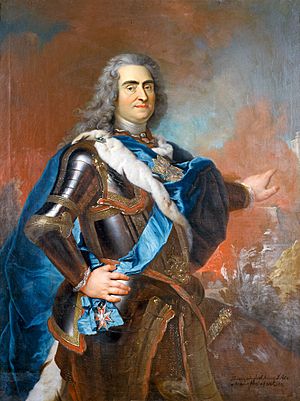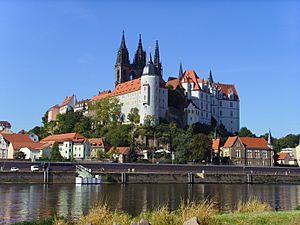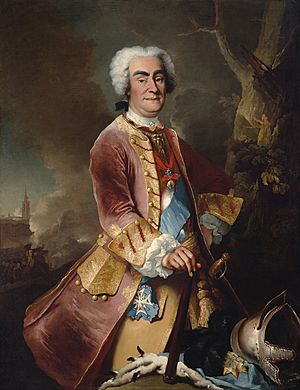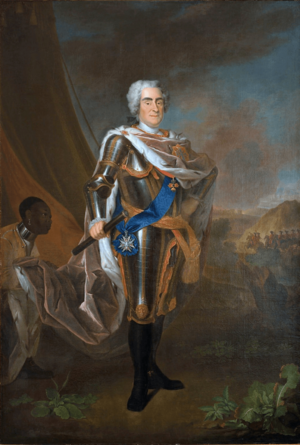Augustus II the Strong facts for kids
Quick facts for kids Augustus II |
|
|---|---|

Portrait of Augustus with the star of the Polish Order of the White Eagle, by Louis de Silvestre
|
|
| Elector of Saxony | |
| Reign | 27 April 1694 – 1 February 1733 |
| Predecessor | John George IV |
| Successor | Frederick Augustus II |
| King of Poland Grand Duke of Lithuania |
|
| Reign | 15 September 1697–1706 |
| Coronation | 15 September 1697 Wawel Cathedral, Kraków, Poland |
| Predecessor | John III |
| Successor | Stanisław I |
| Reign | 1709 – 1 February 1733 |
| Predecessor | Stanisław I |
| Successor | Stanisław I |
| Born | 12 May 1670 Dresden, Electorate of Saxony |
| Died | 1 February 1733 (aged 62) Warsaw, Polish–Lithuanian Commonwealth |
| Burial |
|
| Spouse | Christiane Eberhardine of Brandenburg-Bayreuth |
| Issue more... |
|
| House | Wettin |
| Father | John George III, Elector of Saxony |
| Mother | Princess Anna Sophie of Denmark |
| Religion |
|
| Signature |  |
Augustus II (12 May 1670 – 1 February 1733), often called Augustus the Strong, was an important ruler in Europe. He was the Elector of Saxony from 1694. He also served as King of Poland and Grand Duke of Lithuania from 1697 to 1706, and again from 1709 until his death in 1733. He belonged to the House of Wettin, a powerful royal family.
Augustus was known for his incredible physical strength. People called him "the Strong," "the Saxon Hercules," and "Iron-Hand." He liked to show off his strength by breaking horseshoes with his bare hands. He was also a great supporter of arts and building projects.
To become king of the Polish–Lithuanian Commonwealth, Augustus changed his religion to Roman Catholicism. As a Catholic, he received the Order of the Golden Fleece from the Holy Roman Emperor. He also created the Order of the White Eagle, which is Poland's highest award. As the Elector of Saxony, he made Dresden a major cultural city. He brought artists from all over Europe to his court. Augustus also collected many artworks and built grand baroque palaces in Dresden and Warsaw.
His time as king in Poland was sometimes difficult. He led the Polish–Lithuanian Commonwealth in the Great Northern War. This war allowed the Russian Empire to become more powerful in Europe, especially in Poland. Augustus wanted to make the king's power stronger in Poland, which was very decentralized compared to other countries. He tried to do this with help from other countries, which sometimes made things unstable. He ruled Poland with a break; from 1706 to 1709, a nobleman named Stanisław Leszczyński was king instead. After Augustus died in 1733, it led to the War of the Polish Succession.
Augustus's body was buried in Poland's royal Wawel Cathedral in Kraków. However, his heart rests in the Dresden Cathedral in Germany. His only official son, Augustus III of Poland, became king in 1733.
Contents
Early Life and Family
Augustus was born in Dresden, Germany, on 12 May 1670. He was the younger son of John George III, Elector of Saxony and Princess Anna Sophie of Denmark. Since he was the second son, he didn't expect to become the Elector of Saxony. His older brother, Johann Georg IV, took over after their father died in 1691. Augustus received a good education and spent several years traveling and fighting against France.
Augustus married Kristiane Eberhardine of Brandenburg-Bayreuth on 20 January 1693. They had one son, Frederick Augustus II (1696–1763). This son later became Elector of Saxony and King of Poland, known as Augustus III.
While Augustus was in Venice, his older brother, Johann Georg IV, sadly died from smallpox in 1694. Because Johann Georg had no official children, Augustus became the new Elector of Saxony, known as Friedrich Augustus I.
Why Did Augustus Change His Religion?
To become eligible for election as king of the Polish–Lithuanian Commonwealth in 1697, Augustus had to become a Roman Catholic. This was a big deal because the rulers of Saxony had traditionally been strong supporters of the Protestant faith. Saxony was a major center for German Protestantism.
Augustus's decision to convert was quite shocking to many Protestants in Europe. Even though he promised to protect Saxony's Protestant religion, his conversion made many of his Protestant subjects unhappy. He also spent a lot of money to convince Polish nobles and clergy to vote for him. Some people jokingly called his goal to become king his "Polish adventure."
Augustus's religious policy in the Holy Roman Empire still followed the Lutheran faith. This was different from his new Catholic beliefs. Protestant princes in the empire wanted Saxony to remain part of their group. According to the Peace of Augsburg, Augustus could have brought back Roman Catholicism to Saxony. However, he never did. Saxony remained mostly Lutheran, and the few Roman Catholics there did not have many political or civil rights.
The wife of Augustus, Electress Christiane Eberhardine, refused to become Catholic. She remained a strong Protestant. She did not attend her husband's coronation in Poland and lived a quiet life outside Dresden. Many people admired her for sticking to her beliefs.
Becoming King of Poland (First Time)

After Polish King John III Sobieski died, Augustus was chosen as King of the Polish–Lithuanian Commonwealth in 1697. He had support from Imperial Russia and Austria, who helped him financially. Some people questioned if Augustus's election was legal because another candidate, François Louis, received more votes. However, Augustus quickly arrived in Poland with a Saxon army, while Conti stayed in France.
Augustus continued the war against the Ottoman Empire as part of the Holy League. His Polish army defeated the Tatars at the Battle of Podhajce in 1698. This victory led to the Ottoman Empire signing the Treaty of Karlowitz in 1699. This treaty returned the regions of Podolia and Kamieniec Podolski to Poland.
Augustus was an ambitious ruler. He hoped to make the Polish throne something his family could inherit. He also wanted to use his power as Elector of Saxony to bring more order to the Polish–Lithuanian Commonwealth, which was quite disorganized. However, he soon became focused on external conquests. He formed an alliance with Frederick IV of Denmark and Peter I of Russia. Their goal was to take land from Sweden's young King Charles XII. Poland was supposed to gain the Swedish territory of Livonia from this war.
However, Charles XII proved to be a very skilled military leader. He quickly forced Denmark out of the war and then pushed back the Russians at Narva in 1700. This allowed him to focus on fighting Augustus. This war, known as the Great Northern War, ended up being very bad for both Sweden and Poland.
Charles defeated Augustus's army at Riga in July 1701. This forced the Polish-Saxon army to leave Livonia. Charles then invaded Poland, capturing Warsaw in May 1702. He defeated the Polish-Saxon army again at the Battle of Kliszów in July 1702 and took Kraków. He also defeated another of Augustus's armies at the Battle of Pułtusk in 1703 and captured Toruń.
By this time, Augustus wanted peace. But Charles felt he would be safer if he had someone he could control on the Polish throne. In 1704, the Swedes put Stanisław Leszczyński on the throne. This forced Augustus to start military actions in Poland with Russia's help. A civil war broke out in Poland from 1704 to 1706, which did not go well for Augustus. After the Battle of Fraustadt, Charles invaded Saxony in 1706. This forced Augustus to give up the Polish throne to Leszczyński in the Treaty of Altranstädt in October 1706.
Meanwhile, Russia's Tsar Peter had improved his army. He dealt a huge defeat to the Swedes at the Battle of Poltava in 1709. This marked the end of the Swedish Empire's power and the rise of the Russian Empire.
Becoming King of Poland (Second Time)

The Polish–Lithuanian Commonwealth became weaker and was seen almost as a country protected by Russia. In 1709, Augustus II returned to the Polish throne with Russia's support. He tried again to create an absolute monarchy in Poland, where the king has all the power. However, he faced strong opposition from the Polish nobility, called the szlachta. He was also hindered by the jealousy between the Saxons and the Poles. A conflict broke out in Poland, which only ended when the king promised to limit his army in Poland to 18,000 men.
Peter the Great of Russia used this opportunity to act as a mediator. He threatened the Commonwealth with his military. In 1717, he forced Augustus and the nobility to sign an agreement that favored Russian interests. This agreement was made at the Silent Sejm (Sejm Niemy).
For the rest of his reign, Augustus depended on Russia (and sometimes Austria) to keep his Polish throne. He gave up his big plans for his family to inherit the throne and focused on trying to strengthen the Commonwealth. However, with opposition from both inside and outside the country, he achieved little. In 1729, he founded the Grand Musketeers Company in Dresden, one of the oldest Polish officer schools. It moved to Warsaw in 1730.
Augustus died in Warsaw in 1733. Even though he couldn't make the Polish throne hereditary for his family, his oldest son, Frederick Augustus II of Saxony, did become King of Poland as Augustus III of Poland. However, he needed the Russian army to help him take the throne during the War of the Polish Succession.
Augustus II's Legacy
Augustus II and the Arts

Augustus is perhaps best remembered as a great supporter of arts and architecture. He had beautiful palaces built in Dresden, making the city famous for its amazing culture. He opened the first public museums, like the Green Vault in 1723. He also started collecting paintings systematically, which are now shown in the Old Masters Gallery.
From 1687 to 1689, Augustus traveled through France and Italy. He was very impressed by the grand court at the Palace of Versailles. Augustus invested a lot in making his main home, Dresden Castle, look magnificent. He wanted to show off his wealth and power, which was common during the baroque period.
With strict building rules and big city plans, Augustus began to transform Dresden into a famous cultural center. It became home to one of Germany's best art collections. Most of the city's famous sights were finished during the reign of his son, Augustus III. The most famous building started by Augustus the Strong was the Zwinger. Other notable places include Pillnitz Castle, his summer home, and his hunting lodges, Moritzburg Castle and Hubertusburg Castle. He greatly expanded the Saxon Palace in Warsaw and the nearby Saxon Garden. This garden became the city's oldest public park and one of the first public parks in the world. He also expanded the Wilanów Palace.
He was a man who enjoyed life and sponsored grand court balls, masked parties, and luxurious gatherings. His court became known throughout Europe for its extravagance.
Meissen Porcelain

Augustus II successfully supported efforts to discover how to make porcelain. In 1701, he helped a young alchemist named Johann Friedrich Böttger. Böttger had run away from the king of Prussia, Frederick I, who wanted him to make gold.
Augustus kept Böttger and tried to make him reveal the secret of making gold. Böttger, who was an alchemist, not a potter, realized that mixing fine white powders into clay wouldn't work. Instead, he tried baking clay at much higher temperatures than ever before in Europe. This led to the breakthrough that European potters had been trying to find for a century. By the king's order, the Royal-Polish and Electoral-Saxon Porcelain Manufactory was set up in Meissen in 1709. The making of fine porcelain continues at the Meissen porcelain factory today.
Order of the White Eagle
In November 1705, in Tykocin, Augustus founded the Order of the White Eagle. This was Poland's first and most important order of chivalry. In 1723, he bought the Großsedlitz estate near Dresden. After making the palace and garden complex bigger, he held the first celebrations of the Order of the White Eagle there in 1727. In Warsaw, the Saxon Garden (in Polish: Ogród Saski) remembers Augustus II's role in expanding the city's public spaces.
Other Facts
Augustus II was called "the Strong" because of his amazing physical strength. He was 1.76 meters (about 5 feet 9 inches) tall, which was taller than average for his time. Despite his great strength, he didn't look huge. In his later years, he suffered from diabetes and became quite heavy. When he died, he weighed about 110 kilograms (242 pounds). Augustus II's body was buried in the Wawel Cathedral in Kraków, but his heart rests in the Dresden Cathedral.
Film
In 1936, a Polish-German film called Augustus the Strong was made about him. It was directed by Paul Wegener, and the actor Michael Bohnen played Augustus.
Royal Titles
- In Latin: Augustus Secundus, Dei Gratia rex Poloniae, magnus dux Lithuaniae, Russie, Prussiae, Masoviae, Samogitiae, Livoniae, Kijoviae, Volhyniae, Podoliae, Podlachiae, Smolensciae, Severiae, Czerniechoviaeque, necnon haereditarius dux Saxoniae et princeps elector etc.
- English translation: Augustus II, by the grace of God, King of Poland, Grand Duke of Lithuania, Ruthenia, Prussia, Masovia, Samogitia, Livonia, Kiev, Volhynia, Podolia, Podlachia, Smolensk, Severia and Chernihiv, and Hereditary Duke and Elector of Saxony, etc.
Portraits by
- Rosalba Carriera
- Louis de Silvestre
See Also
 In Spanish: Augusto II de Polonia para niños
In Spanish: Augusto II de Polonia para niños
- History of Saxony
- History of Poland (1569–1795)
- Rulers of Saxony
- List of Lithuanian rulers
- Dresden Castle – Residence of Augustus II the Strong
Images for kids









